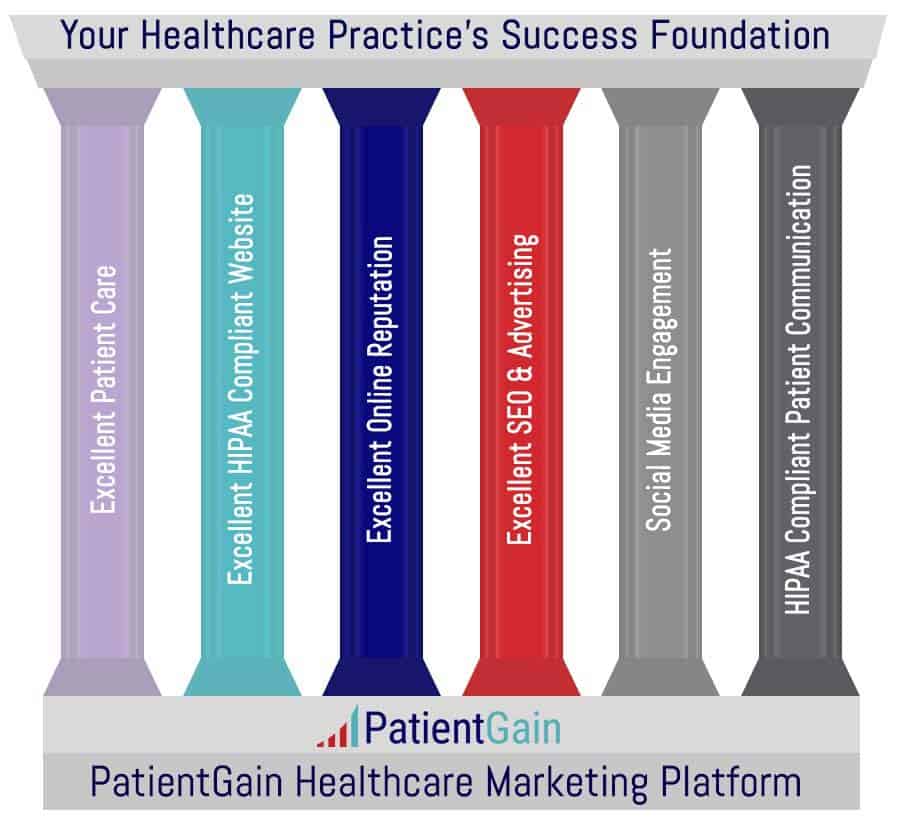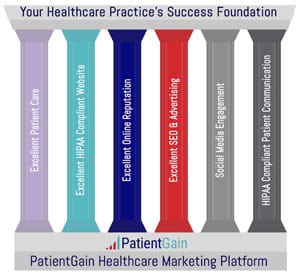What is Medical Marketing For Doctors?
Medical Marketing is also known as healthcare marketing or if you are a dentist, dental marketing. It is not one thing, it is a combination of your medical services, how you present your medical or dental practice, your staff, your website, your SEO, your software, your online reviews, your traditional advertising, your social media, your digital presence and online advertising.
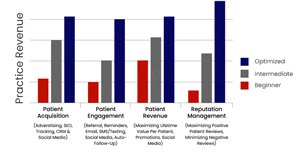

Medical Marketing Insights from PatientGain
- New Practices Spend More: New or expanding practices often allocate 20% or more of expected revenue to advertising, sometimes exceeding these ranges to establish market presence.
- Digital Marketing is Dominant: Over 70% of marketing budgets are directed towards online advertising, especially Google Ads and social media.
- SEO as Long-Term Investment: Many practices use PatientGain’s SEO services to build sustainable, organic patient acquisition alongside paid ads.
- Tracking and Analytics: PatientGain emphasizes integrated analytics dashboards, known as live marketing dashboards, allowing practice managers to monitor CPL(cost per lead) , ROI (return on investment), lead sources, and optimize spending in real-time.
According to US gov “Health Marketing involves creating, communicating, and delivering health information and interventions using customer-centered and science-based strategies to protect and promote the health of diverse populations (CDC & Wikipedia).” Referenced here. For a practice, in simple terms, it is simply promoting three important aspects of your medical practice 1) Promoting the key medical services and procedures 2) Promoting your brand, location, name, your reviews and benefits of your practice to patients 3) Promoting the providers, their accomplishments, degrees, and contributions to the community. Your practice’s medical marketing should also be inclusive. Inclusive medical marketing that positively represents plus-size patients, will not only improves your brand, public image but it is also a revenue magnet. Ethical communication in medical marketing is essential because patients depend on accurate, trustworthy information to make informed decisions about their health.
What is the goal of medical marketing for doctors and medical practices?
The primary goals of medical marketing for doctors are to attract and retain patients, build a strong brand, and ultimately grow the practice. By utilizing effective marketing strategies, doctors can increase visibility, establish trust, and drive patient engagement. Here’s a breakdown of the key objectives:
1. Patient Acquisition
- Attract New Patients: Use targeted marketing to reach people actively seeking medical care in the practice’s specialty.
- Expand the Patient Base: Increase the overall number of patients through marketing channels like SEO, PPC, and social media.
- Generate Leads and Convert into Appointments: Drive inquiries and schedule consultations to convert leads into new patients.
2. Patient Retention
- Encourage Return Visits: Develop strategies to keep existing patients coming back for regular check-ups, follow-up appointments, and preventative care.
- Build Strong Relationships: Foster trust through excellent patient care, communication, and engagement strategies.
- Reduce Patient Churn: Identify reasons patients leave and implement strategies to enhance satisfaction and retention.
3. Brand Building
- Establish a Strong Brand Identity: Define the practice’s unique values, strengths, and approach to patient care, distinguishing it from competitors.
- Position as a Leader in the Field: Promote expertise in specific areas of medicine (e.g., dermatology, surgery, pediatrics) to attract patients seeking specialized care.
- Build a Positive Reputation: Leverage online reviews, patient testimonials, and word-of-mouth referrals to enhance the practice’s credibility and trustworthiness.
4. Educational Outreach
- Provide Valuable Health Information: Use content marketing (blogs, videos, newsletters) to educate patients about common medical conditions, treatments, and healthy lifestyle practices.
- Promote Preventative Care: Encourage patients to prioritize wellness and prevention, leading to long-term patient relationships.
- Position the Doctor as a Trusted Source: Establish the practice as a go-to resource for reliable and accurate health information.
By effectively implementing these medical marketing strategies, doctors can achieve their goals of patient acquisition, retention, and engagement, ultimately improving their practice’s success and profitability.
Example of a Medical Marketing Dash Board of a 7 Location Medical Practice
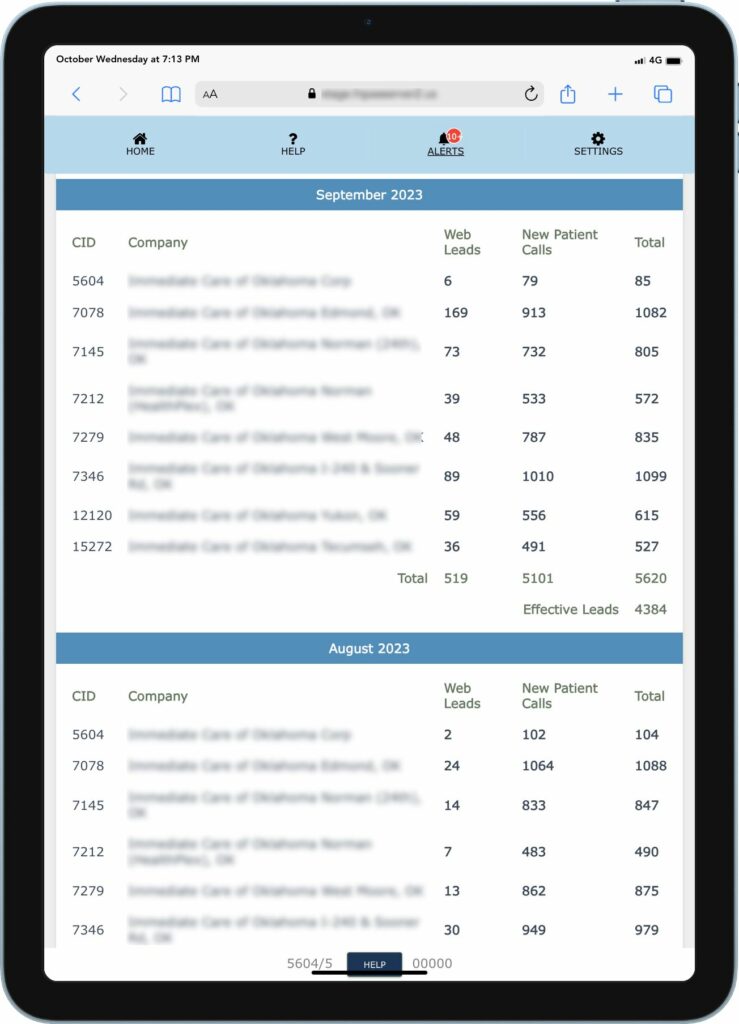
Example of a Medical Marketing Dash Board of a 1 Location Medical Spa
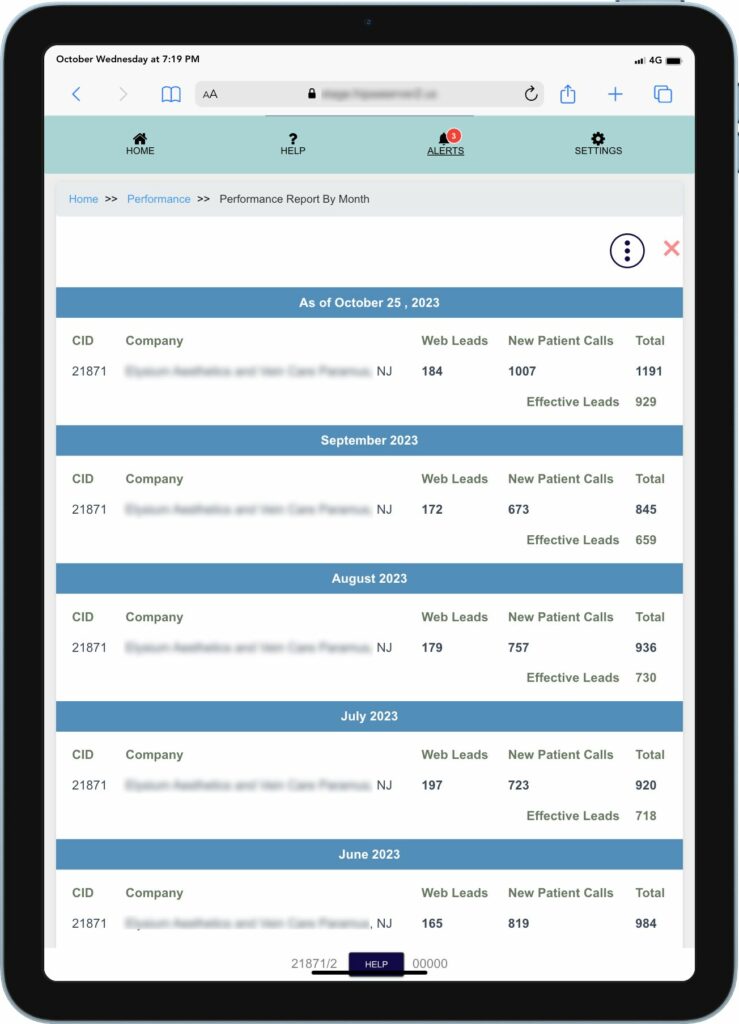
Example of a Medical Marketing Dash Board of a 7 Location Neuro & Spine practice
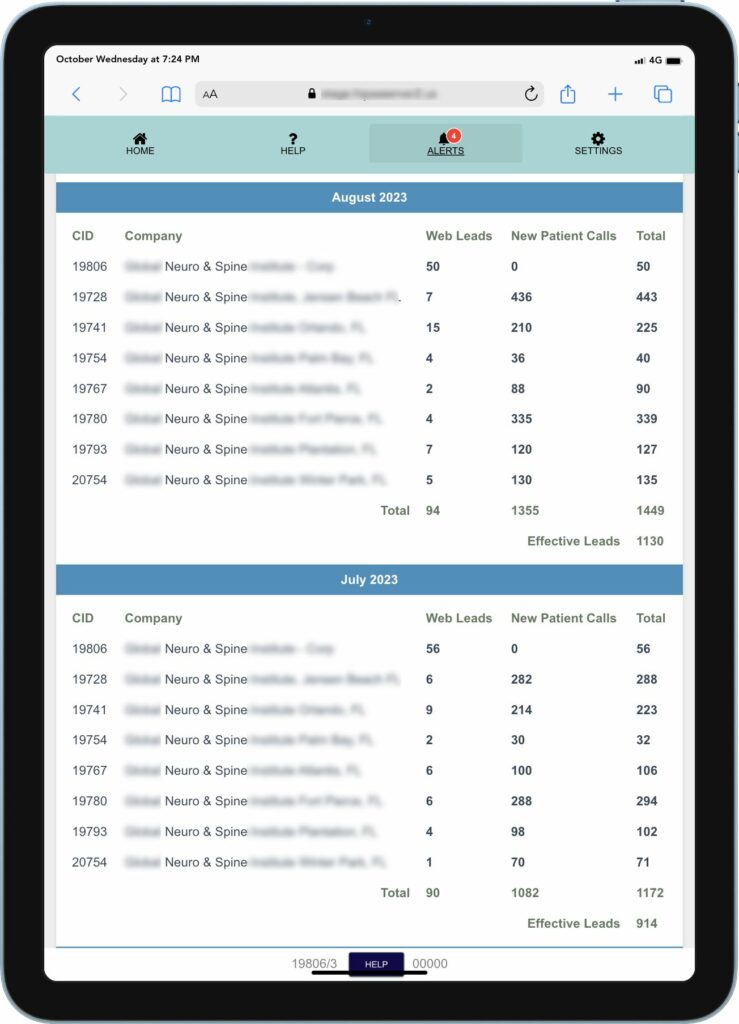
Marketing for medical practices does not have to be boring, or uninteresting text only. Example of a promotion for an internal medicine and functional medicine practice.


Table of Contents
Question 1: How do you market a medical practice?
Question 2: Is a website required for my medical practice?
Question 3: Can I just get one those free websites and add my name to it?
Question 4: Why does it have to be so hard, I can just get it done once and forget about my online headaches?
Question 5: I have heard the medical marketing is complex these days, but do I really need a specialized healthcare marketing company?
Question 6: I have been told that my SEO is low because my website content is not “unique”, what does this mean?
Question 7: What exactly is Medical SEO?
Question 8: What is Local SEO?
Question 9: What is Technical Medical SEO?
Question 10: Can I just “buy” SEO and get it over with?
Question 11: Which one is better? medical SEO or medical advertising?
Question 12: Are there any specific steps strategies that I should avoid?
Question 13: What is included in healthcare marketing?
Question 14: For my medical marketing website, why can’t I just use a drag and drop website builder?
Question 15: Is there a project manager included in PatientGain’s healthcare marketing?
Question 16: Are there any monthly account reviews included in PatientGain’s healthcare marketing?
Question 17: What is the impact of COVID-19 pandemic on a clinic’s healthcare marketing?
Question 18: How do you calculate ROI (Return On Investment) of a medical marketing campaign?
Question 19: How do I see results from my investments in medical marketing?
Question 20: What is medical marketing funnel for healthcare practices & how does it benefit my practice?
Question 21: For my practice’s medical marketing, do you provide or write content?
Question 22: For my practice’s medical marketing, should I setup Facebook or Instagram campaigns?
Question 23: How does Facebook and Instagram tracking work?
Question 24: What is schema, and how does it impact the SEO of my medical website?
Question 25: Do I need to “Socialize” and be present on every social media website?
Question 26: I want to run advertising campaigns on Google and Facebook, but only ON and OFF when I need patients?
Question 27: How do wait times impact a patient’s positive experience?
Question 28: What good guidelines can a medical practice follow to ensure they remain HIPAA compliant when developing a digital marketing plan?
Question 29: How do you start your medical marketing campaigns?
Question 30: Is technical SEO important? I have rec’d multiple sales people calling me that my technical SEO is not good?
Question 31: I have grown my medical practice over the last 10+ years, and I am using so many apps and service providers, how can I simplify?
Question 32: Why do health care business owners often choose digital marketing for the healthcare services they offer?
Question 33: What Does a Medical Marketer Do? Do I Need One?
Question 34: Why is conversion rate important?
Question 35: What are examples of a patient conversion?
Question 36: What are the benefits of using patient healthcare surveys for my practice?
Question 37: How to Build the Brand of Your Healthcare Practice and Your Doctor / Dentist?
Question 38: Does the design of my healthcare website impact my medical marketing?
Question 39: Does the number of providers in my target area increase my healthcare advertising costs?
Question 40: Does it make any difference if my healthcare website domain is with Google domains VS some other domain hosting company?
Question 41: Why should I use medical marketing database? I am already paying for a an EMR?
Question 42: What is ADA compliance for medical websites? and do I need it?
Question 43: Which search engines are used mostly by patients?
Question 44: Which social media sites are used mostly by patients?
Question 45: Is it safe to use Facebook messaging apps for healthcare marketing?
Question 46: What is Patient Journey and Engagement?
Question 47: What are the 5 P’s of medical marketing?
Question 48: What is a PLATINUM service from PatientGain?
After serving hundreds of medical practices in the United States and Canada, we firmly believe that in order to help medical practices with their medical marketing, the medical marketing company is required to be a specialist in the field of medicine. Medical marketing will not function unless there is patient trust and commitment from the doctors, providers, practice owners to invest and improve their marketing tactics. They have to understand that this is a field where many physicians still hold onto the belief that it is unethical to advertise. In many cases they are still advertising through traditional methods such as radios, printed postcards, newspapers and yellow-pages.
To learn about how new patient acquisition works, this is a very good page to start.
An introduction to medical marketing for doctors can also help you understand the detailed steps.
In real world, there is no one simple way to become successful. This applies to medical practices and doctors also. You must have a plan to “distinguish” your services, (also known as branding) your practice and improve your online presence. Building patient trust and providing excellent for your patients is the foundation on your success. You also want to monitor and improve your marketing tactics. Online advertising is a big part of medical marketing. It can be the most expensive part of your overall online marketing plan. Medical advertising data about how much doctors spend on advertising, is a designed to provide competitive data from other clinics like yours.
Empathy, compassion, and humor are very powerful to use in medical marketing because they are emotions people enjoy relating to most frequently. When you market your medical practice to your target audience, tell an emotional story about how your services helped someone resolve their medical issue.
We looked at 3116 medical websites in USA and Canada. We reviewed the online strategy and apps and code embedding the web sites. Results are that only 6.1 percentage of the medical professionals are using conversion apps and techniques to capture the leads and convert them to paying patients. Read more about medical marketing ROI. You can take specific steps, starting this week, to improve your patient acquisition steps. Basically, healthcare marketing is changing. There is a very good paper “The impact of marketing strategies in healthcare systems“. In this paper, the author describes that over the past decade, healthcare has experienced many marketing trends that have fundamentally altered marketing. These trends are the follows:
- From a mass marketing approach to a more specific approach.
- From image marketing to service marketing.
- From “one measure for all” to personalization.
- From the emphasis on a health episode to a long-lasting relationship
- From “ignoring” the market, to market intelligence.
- From low-tech to high-tech (Thomas RK. Health Services Marketing, A Practitioner’s Guide, 2008, Ed. Springer).
Your overall medical marketing strategy should be based on best practices and on a pattern of success of other similar medical practices. It should not be based on trial-and-error, and waste of your hard earned money. This is why PatientGain recommends A/B tested websites and strategies.
47 Good medical marketing questions asked by providers and practice managers:
Answer: You start with the medical practice’s website first. Make sure it is optimized for Google SEO, the site should be A/B tested, it is mobile friendly and added to Google search engine’s index. Medical marketing, also known as healthcare marketing, involves strategies and techniques to promote medical services, engage patients, and enhance the reputation and visibility of healthcare providers and organizations. It works through several core components and strategies:
1. Understanding the Target Audience
Demographics: Identifying specific patient groups based on age, gender, conditions, and geographic locations.
Needs and Preferences: Understanding what services potential patients are seeking and how they prefer to receive healthcare information.
2. Digital Marketing
Website and SEO: Developing a professional website that is optimized for search engines to attract more organic traffic. a) Content is tailored to address common patient concerns and include keywords relevant to the practice’s services.
b) Next add/update Google business listing also called GMB (Google My Business) c) Website should not have any plagiarized content. d) Create a Facebook and Instagram page e) Setup Email marketing campaign f) Start Google PPC ads g) Investigate if Facebook ads will help your practice h) Focus on improving online reputation for your medical practice i) Add useful apps to your website, like, ChatBot, Texting/SMS from website and appointment requests.
Social Media: Engaging with patients on platforms like Facebook, Instagram, and YikTok to build relationships and keep the practice top of mind.
Online Advertising: Using PPC (Pay-Per-Click), display ads, and retargeting to reach potential patients more directly and personally.
3. Content Marketing
Blogs and Articles: Writing informative content that addresses common health issues or questions, which helps establish the practice as a thought leader in its field.
Video Content: Creating video tours of the facility, interviews with staff, or educational videos on health topics to engage more visually oriented users.
4. Reputation Management
Patient Reviews and Testimonials: Encouraging satisfied patients to leave positive reviews online and using patient testimonials in marketing materials to build trust with prospective patients.
Handling Negative Feedback: Addressing complaints and negative reviews promptly and professionally to maintain a positive public image.
5. Local Marketing
Community Involvement: Participating in community events or health fairs to increase visibility.
Local SEO: Optimizing for local search queries to ensure the practice appears in search results when potential patients look for healthcare providers in their area.
6. Referral Marketing
Networking with Other Professionals: Establishing relationships with other doctors and health professionals to receive referrals.
7. HIPAA Compliance
Adhering to Regulations: Ensuring all marketing materials and strategies comply with health information privacy laws (like HIPAA in the U.S.) and advertising regulations.
Medical marketing aims to not only attract new patients but also retain existing ones by improving patient engagement and satisfaction. Effective marketing strategies can significantly enhance a practice’s visibility, improve patient relationships, and ultimately increase revenue.
Answer: Yes. If you are a medical professional and you want to grow your practice, time has come to get a professional medical website that is designed for high conversion and high medical SEO.
Answer: Yes you can, but the chances are you will not be able to compete with you competition. Digital landscape has changed significantly in the last few years. It is simply not possible to have a static website and think that your potential and existing patients can find you online. We recommend investing high quality medical marketing website, that is based on original SEO content, and A/B tested design for high conversion.
Answer: Unfortunately, it is not as simple as that. Medical marketing for doctors requires multiple steps and processes. It is not a one time “switch”. It takes time and quite a bit of money. It also requires commitment and engagement from the medical practice owner or practice manager.
Answer: Yes, you do. It is complex and getting more complex everyday. Having an excellent medical marketing company for your medical practice is key to your success. As a physician, you already know how to treat various illnesses and injuries. You see symptoms, and then you determine the best treatment for them to feel better. Promoting your medical practice to make it successful is not that different! The experts at PatientGain.com will work with you, side by side, to develop a “treatment plan” to rid your healthcare marketing of any symptoms that could be holding it back and help you grow your patient count. A good medical marketing company should provide:
1) Service that suits your practice’s marketing needs
2) Should provide quality service that earns your trust
3) Focuses on long term growth of your practice, while still delivering short term immediate results
4) Service should provide you options, at reasonable rates
Answer: The content of your website is often the most influential factor in how it will perform in making your business a success. “Content is King” is not only a catchy phrase but, in many cases, very true. Medical SEO of your website requires that you have high quality content on your website. You cannot copy and paste content from another website. Basically you would hurt your own SEO. Search engines are very intelligent, they can determine if you have plagiarized content on your website
Answer: Marketing for Doctors offices is not a “sales technique”. It is the strategic process of attracting, retaining, and building trust with patients by showcasing expertise, improving visibility (especially online), and creating excellent patient experiences, using digital tools (SEO, social media, reviews, content) and traditional outreach, all while adhering to HIPAA and focusing on patient needs and outcomes. It’s about building long-term relationships and positioning the practice as a trusted resource in the community, not just advertising.
There are 4 important areas
1) A professional website that represents you and your brand. Website should be focused on having useful information about help helping patients, new and existing patients.
2) Search Engine and AI Search Engine optimized. Must have new, fresh content every month. Thi sis your long term strategy for patient acquisition. This also includes Local SEO and posting on Google Business Profile, a free tool that allows businesses to manage their online presence on Google Search and Maps.
3) Advertising on Google – using PPC ads is very effective and brings in new patients quickly, however it is very expensive. We have seen very good ROI (Return On Investment) with Google PPC ads.
4) Constant improvement to your marketing strategy using automation and artificial intelligence a) Email marketing (monthly) b)Improving conversion of the website – example, adding SPOC app to your website c) tracking of patient calls d) allowing patients to text you from the website to ask common questions e) adding complete bios of providers d) posting on Google Business Profile every month, atleast 20 times per month.
Answer: Local SEO for doctors is also known as Local Medical SEO. This is a strategy that helps your medical website to appear in the top area of Google search results. This area usually appears after the paid ads. This has 4 specific areas 1) Google maps 2) Business listing 3) Google reviews and rankings 4) Links to website and phone number. Medical local SEO is extremely important for your medical marketing for doctors.
Local SEO for doctors is a digital marketing strategy to make a medical practice visible in local online searches (like “dentist near me” or “pediatrician in [City]”), ensuring it appears in Google Maps and local results to attract nearby patients looking for specific services, boosting appointments and reputation.
The most important part of local SEO for doctors is optimizing the GBP tactics include optimizing a Google Business Profile (NAP, hours, photos, reviews), using location-specific keywords on the website, and building local online presence. For example – posting on Google Business Profile is very important. Posting 20 times a month produces the best results.
Example of a complete GBP 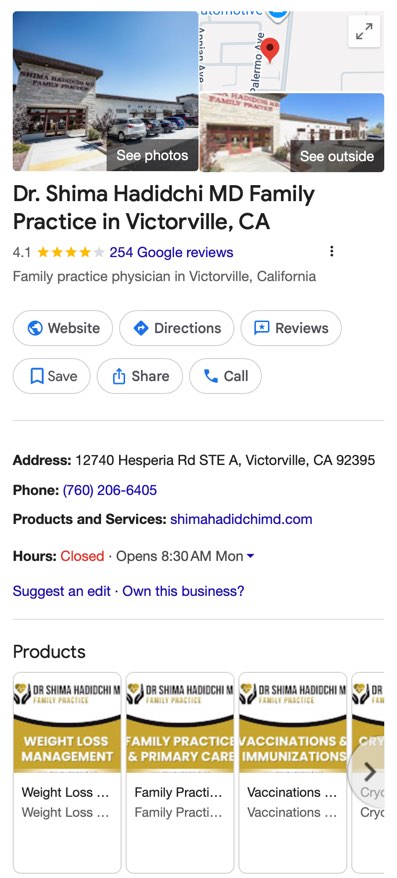
Answer: Technical SEO is the technical parts of your website that make your website work. Making sure these elements are running without any problems can help boost your overall organic search ranking. Technical SEO is a subset of On-Page SEO, but this aspect does not focus on the content that is on your website but other essential factors that impact your organic rankings and overall website performance.
Answer: No, you cannot “buy SEO” from Google. You have to build your website’s medical SEO rankings over a period of time. It takes a lot of time and effort (hence money) to build the medical SEO of your clinic’s website. Yes, it is free from Google’s perspective. When compared to Google search ads, medical SEO and local SEO for doctors, dentists and other type of practices is free. However there are 2 main ways to build your SEO over time. 1) Do it yourself 2) Hire a professional medical marketing company in US and Canada. We recommend no 2.
Answer: The goal of both medical SEO (Search Engine Optimization) and medical advertising is to put your website in front of the faces of people who are possibly looking for your medical services. Medical SEO works on the organic side of search results while medical advertising works on the paid search result side. Medical SEO is a long-term strategy, taking months if not years to secure top spots, while medical advertising is more immediate.
Both strategies are designed to improve your patient count, and complement each other. They do not replace each other, however there is some overlap. As a healthcare provider, you want to focus on both, if you want to have a thriving business. In rare cases, you will not need medical advertising.
Answer: Yes, you should avoid risky and unproven gimmicks. Remember, if it’s too good to be true, it’s probably a bad idea. Here is very good starting page that outlines risky strategies.
Answer: PatientGain’s 2 most popular healthcare marketing packages are GOLD and PLATINUM. They are both comprehensive service offerings. Generally, your healthcare marketing should include 6 key items: 1) Excellent patient care 2) Your practice’s website 3) Online reputation of your practice 4) Online SEO rankings and online advertising 5) Social media presence involves posts and advertising 6) Patient communication strategy
Answer: Of course you can. However you are not likely to see good results. You should hire a professional medical marketing company like PatientGain or some other company that specializes in healthcare, is HIPAA compliant, and provides key important services for your healthcare practice: 1) Deep healthcare experience 2) Technical team focused on improving your online performance 3) Excellent customer service delivery 4) Website system of proven platform like WordPress 5) Commercial grade WordPress hosting 6) Project manager and technical team for direct access 7) Content writers for medical procedures 8) Medical SEO expertise 9) Digital advertising expertise
Answer: Yes. PatientGain’s monthly services for GOLD and PLATINUM included 2 staff members who are your primary point of contact. 1) Project manager 2) Technical website and apps manager. Both of these staff members can be reached by 1) Texting 2) Email 3) Zoom.us meeting and 4) Scheduled calendar meeting. There is entire team of skill-sets, staff and apps work behind the scene for you. For example, we have dedicated staff who optimize and manage your PPC/Social Media campaigns. Your medical marketing performance dashboards are available to you all the time, from mobile devices and desktop. You also have multiple-user role based access (per HIPAA) for your staff.
Answer: Yes. PatientGain’s monthly services for GOLD and PLATINUM customers includes monthly account reviews. In fact you will meet with your project staff more than once a month, as we launch your medical marketing campaigns.
Answer: Covid-19 pandemic’s negative and long lasting impact is not only on patient’s well being, deaths, it is also impacting negatively many healthcare practices. We see transition towards 1) More telemedicine services 2) More effective online campaigns 3) Less spend on traditional mediums, like billboards 4) More focus and spend on digital advertising 5) More focus on SEO and content marketing.
Answer: The formula for Marketing Return On Investment (ROI) Formula is (Total revenue generated Minus dollars spent on campaign) Divided by dollars spent on the campaign. Lets review a customer example: A medical practice located in California, wanted to launch “medical weight loss” campaign. Using PatientGain’s GOLD service, monthly budget for the campaign was set to $2400 per month, it would run for initially for 6 months. Typically ROI is measured in “times”. See example below.
On average, over the next 6 months the campaign generated 845 inquiries from Google adwords (70% of the budget) and Facebook+Instagram (30%) of the budget, averaging 140 leads per month. With a close ratio of 26 percentage (meaning out of 100 leads, 26 of the leads converted to patients). At 26 percentage, 36 new patients converted from 140. Each patient spends certain amount on the medical weight loss service. Ranging from $300 basic to $4000 package. On average each patient spend is $1800. So on a monthly basis:
Revenue: 36 x $1800 = $64800 /mon
Campaign spend: $2400 / mon
$64800 – $2400 divided by $2400 = 26 X
So the ROI is 26 times
Answer: We highly recommend using a digital marketing company that 1) specializes in healthcare field 2) offers you instant access to your data – meaning that you have live dashboards based on real-time data 3) avoid companies that just send you a monthly SEO report 4) check the medical SEO rankings for the company – for example go to Google an type “medical SEO” and see if they show in the top area of the Google search (Ignore the ads).
Answer: Funnel medical marketing is the journey a patient takes from first being aware of your medical practice to finally become a patient. In other business areas, such as retail, this can sometimes be known as a sales funnel or a conversion funnel. So why is it called or shaped like a funnel? It is shaped like a funnel because the number of people that eventually convert and become patients will be far smaller than the number of people who begin their journey. In other words, if 100 people visit your website for the first time, you should not expect all 100 of those people to become patients eventually. You will lose people along every step of the journey. If you visualize this smaller and smaller pool of potential patients, it begins to look like a funnel. Read more about medical marketing funnels here.
Answer: Yes, we do. We have a team of content writers. Depending on specialty and complexity of procedures, content is assigned to different content writers by your project manager. Content marketing is an essential part of your digital marketing. Content marketing is just not limited to “text” on your website, it should focus on building your brand, and branded images should be used on your website, with quality content. Depending on your service package, we write more content for you.
Answer: Yes, Facebook and Instagram campaigns can add value to your marketing. Facebook and Instagram posts are free, meaning that Facebook and Instagram does not charge you to post content. However the reach of the posts is limited. If you trully want to reach audiences who fit your target patients, you would need to advertise. Facebook and Instagram apps are linked to each other (actually Instagram is owned by Facebook). Creating a Facebook and Instagram campaign can be a simple process. But if you want to get benefit of laser focus advertsing, you will need to spend a lot of time learning and going through trial and error. We counted 44 differnet settings in our Facebook and Instagram settings. So recommend hiring a professional team.
Answer: Facebook and Instagram tracking is done by adding pixel to your website. The pixel is for tracking conversions and getting data from your website visitors. The pixel also allows us to retarget all of your website visitors through Facebook and Instagram. That means any patient who lands on your website through their own research outside of using Facebook, such as they use a Google search or Yahoo to go to your website; The pixel will essentially “cookie” the visitor so we can always stay in front of them through Facebook ads. It is also used for tracking so if a person goes on your website and goes to the “elbow pain” page we can retarget them specifically with ads about elbow pain since they visited that page on your site and that was most likely their pain. This is a common practice in today’s marketing software and conversion tracking. The converted leads are listed in your PatientGain dashboards.
Answer: Schema is another name for structured data markup. Much like other search engine optimization strategies, it helps a search engine gain context and information about your website’s content. The options on what you can mark up using schema are quite large and are organized into a hierarchy of sorts. With schema there are “types.” There are a set of “types” associated with a set of “properties.” Schema, much like all things involved with SEO, is also evolving and changing.
Answer: No – you do not need to be present on every social media website. Only on the important ones. Social Media can be a powerful tool to connect with current and potential patients. On social media channels you can share:
• Announcements
• New Services
• Special hours
• New Hires
• Patient Feedback
• Pictures of your facility
Social media often is the best way to engage with your patients. While you should certainly keep in mind any HIPAA restrictions, it is a great way to answer quick questions and share information about your practice. Don’t fall into the trap of only posting things about your medical practice. Patients do not want to be “sold” to every time. They visit your social media page. Share news about your practice, but also local events and health care news. Many social media channels also allow you to use paid advertising to reach current and potential patients. Advertising on social media allows for more refined targeting compared to search advertising. On social media, you can target not only by location but by gender, age, income, and interests.
Answer: In a perfect world, it would be nice to turn on a switch and start receiving flood of qualified patients only. Real world does not work like this. Just like operating your healthcare practice, running and managing your online healthcare advertising is not easy. Here are some things to avoid. 1) Don’t start and stop campaigns – Data is needed to make adjustments to your campaign. Professional online advertisers, look at the campaign data, keywords, negative keywords, conversion pages, quality of patient behaviour to make adjustments 2) If you have a small budget and you are in a very competitive market, you are NOT likely to see any results 3) Have enough advertising budget for your advertising, basically marketing is NOT equal to advertising. 4) Do not switch advertising mediums too quickly.
Answer: No patient wants to wait to be seen by a doctor, and many patients expect there to be some wait before their appointment begins. However, if they have the impression that a medical practice is not respecting their schedule, they will become frustrated. A medical practice needs to avoid excessive wait times. Over 3/4th of the population say wait times are a significant factor when selecting a doctor. Nearly a quarter of patients have said they have switched doctors solely because of excessive wait times. Communication is vital in these situations. Medical practice needs to be upfront with a patient if they are running behind and giving them an accurate estimation of their wait time in the waiting room. A patient will appreciate honesty and a staff trying their best to keep them informed. Saying “I don’t know” or “In 15 minutes” every 20 minutes will lead to a negative experience.
Answer: Things a medical practice can do:
• Provide general information about treatments to patients and healthcare news. This information should be broad and be used to attract new patient leads.
• Promote the certifications of providers and staff at a medical practice have to showcase their expertise in treatments.
• Share any professional honors providers or staff have received.
• Before placing a patient on an email marketing list, ask for a patient’s permission first.
• Seek out third-party vendors that have experience in maintaining HIPAA compliance.
• Ensure that no PHI identifiers are in any images used for marketing campaigns or social media posts.
Answer: Start with setting up marketing objectives. There are differences between marketing objectives, KPI (Key performance indicators) and goals. See an example from Google’s marketing team below. There are 3 key areas hoe Google’s team looks at results. 1) Monthly objectives (MO) 2) Examples of KPI’s 3) Examples of campaign goals. PatientGain’s dashboards build this data for you automatically and you are able to results from your campaigns in a single dashboard. Medical marketing apps and algorithms from PatientGain leverage machine learning, data mining and intelligence to score conversion rates of your leads. This enables us to add useful, valuable content to your medical website.
Answer: Yes, Technical search engine optimization is very important. Structure and placement of objects on your website is crucial to how Google reads your website. Conversion tracking is also very important. A/B testing and conversion assessment is an ongoing process and cannot be done manually by humans. It requires software tools, experts in design and software engineering. Even Google has many initiatives related to how digital healthcare can be improved.
Answer: This is a common problem. Most practices use anywhere from 3 to 11 different apps. However 5 to 8 is a very common scenario. For example, Dr Tran, has a very successful practice as a aesthetics and dermatology specialist . He has recently opened a second location also. This is how he was setup:
• Website SEO company $450 /mon
• Hosting is on WordPress, on GoDaddy – $40/mon + some additional fees total is $100/mon
• Advertsing on Google $1000/mon + company manages ads, charges him $300/mon, in addition to ads budget
• For social media posting he pays $350/mon. The same company runs ads on Facebook and Instagram Ad budget is $600/mon
• For reputation management, he uses another company $299/mon for the first location, and now the 2nd location will be additional cost
• Email marketing is setup with MailChimp, there are approx 11,000 contacts in the EMR, so the monthly cost s $170/mon – However, it does not include the content for the newsletters that needs to be created, every month. The front desk staff does not have time to do this. Doctor has been looking for someone else to help with this.
• For patient intake forms, the practice tried using the EMR registration process, but patients were not filling out the forms online. So the doctor has hired another company to handle the HIPAA compliant digital forms. $250/month.
• For HIPAA compliant online appointments, the practice has been using ZocDoc, but they have increased their pricing recently based on each provider. Physicians now pay an annual $299 licensing fee, rather than the previous price of $3,000 a year, and pay a charge for new patients booking through Zocdoc that ranges from $35 to $110 based on their specialty.
• To increase patient engagement, practice is using a medical Chat Bot – Cost is $300/mon.
• Practice is also considering HIPAA compliant texting app, so the clinic staff can send texts to patients. This will be another $200 to $300 per month.
Summary: Adding all this up, it is more than $2000 per month, 8+ companies, plus $1600 in advertising on Google and Facebook. This was replaced by a single vendor solution, and costs 50% less with better results, GOLD and PLATINUM service provides all of these services.
Answer: Many owners like how quickly digital marketing can respond to their needs compared to traditional marketing methods. While results can take time to appear, an owner can update and change their digital marketing plan quickly compared to traditional methods. For example, if an owner wants to change a digital ad, they need to upload a new picture. If it was a billboard, chances are they are stuck with that choice for several months.
Some of the most widely used and effective digital marketing techniques used today include:
• Search Engine Optimization (Learn more about SEO for doctors and dentists)
• Pay Per Click Advertising (Learn more about PPC advertising for doctors and dentists)
• Social Media (Learn more about social media marketing for doctors and dentists)
• Content Marketing (Learn more about content marketing for doctors and dentists)
• Mobile Marketing (Learn more about mobile marketing for doctors and dentists)
• Email Marketing (Learn more about Email marketing for doctors and dentists)
Answer: In a summary, am medical marketer’s task is to execute a medical practice’s marketing plan, and build the business for a provider. A medical practice needs to promote its business to be successful and compete with other medical practices in a community. The owner and doctors at a medical practice are entirely too busy to give the proper amount of attention to marketing their healthcare business. With that in mind, a medical marketer is often tapped to provide marketing support for a medical practice. They have a wide range of skills and marketing strategies to successfully promote a business and work with doctors, owners, and other stakeholders to develop an effective medical marketing plan. Learn more about how a medical marketer can improve your practice.
Answer: For a medical practice, having a medical website is key to their success. In today’s modern world, a business has difficulty functioning without a website to promote it. However, a medical website is not a static marketing property that when launched patients will automatically come bursting through the front door. Some websites will bring many patients to a practice while others will not. A website must convert visitors into patients. Building a website with reasonable conversion rates will help fuel the growth and success of a medical practice. The conversion rate is a percentage of success with the goal a medical practice is trying to achieve. For example, if a website received 100 visitors from your SEO campaign, or Google ads campaign or Facebook/Instagram campaign, and 12 of those visitors made an appointment, the conversion rate would be 12%. (Number of appointments divided by the number of website visitors.) What percentage number indicates a good conversion rate is a bit trickier to determine. Good conversion rates will depend on various factors, such as the field of medicine being promoted, competition in the area, and what services are being offered to name a few. For many medical practices, somewhere around 3% to 5% is considered to be a good start. Also every keyword produces different conversion results. For example, if a patient is looking for a “med spa near me beverly hills” vs “sculptra injections near me”, there will be a significant difference in the conversions. The patient who is looking for an certain service, if lands on a conversion focused useful page, if more likely to take a conversion action.
Again, this varies from practice to practice. If a medical practice wants to increase conversion rates, there are ways to do it, but it is a gradual process. Jumping from 3% to 10% overnight is not a realistic. Learn more about conversion strategies for dental and medical websites here.
Examples of a conversion action:
1. Patient calling you from the phone number listed on the website
2. Patient requesting an appointment from the website
3. Patient registering for the patient-portal account
4. Patient starting a ChatBot session from the website site
5. Patient sending a Text/SMS from the website texting app for a 2-Way texting session
6. Patient clicking on “Directions” app (for an urgent care or a walk in clinic)
7. Patient filling out patient registration form on the website
8. Patient taking an “assessment” from the online assessment app
9. Medspa client taking a “quiz” from the online quiz app
10. Patient fills out “contact us” form and sends to the practice.
Conversion techniques are complex, and should be based on A/B testing algorithms. Learn more about conversion strategies for dental and medical websites here.
Answer: Using online surveys is a very effective way for a medical practice to collect feedback from patients to improve their overall business. However, only a tiny portion of medical clinics and doctors use this tool to their fullest potential. Patient satisfaction surveys can provide a medical practice a competitive advantage over their local competitors by giving insight into improving a patient’s experience. Plus, improved patient engagement will show patients that a medical practice cares about their opinion and experiences, which will lead to more appointments and revenue. Learn more about how HIPAA compliant patient surveys can help your healthcare marketing.
Answer: Depending on the healthcare services you are offering, there may be many competitors who are all after the same pool of patients. To stand out from the rest, you need to build a brand for your medical practice. Instead of blending in with the rest, you need to distinguish yourself from the rest of your colleagues. A way to effectively do this is to build a brand for your medical practice. There are 2 important aspects of building the brand. 1) Building the brand of the practice 2) Building the brand of the provider (doctor, dentist, surgeon etc). They are both equally important. Read more about how to brand your practice and your own self.
Answer: Short answer is a resounding YES. The design of your healthcare website can be significant factor in your digital success. Websites need to be mobile-friendly, as this impacts their rankings in search engines and how often visitors are converted into patients. Many medical practices assume that “mobile-friendly” means the website works just as well on a phone as it does on a desktop. While this is a critical component, a medical practice can have an additional advantage over its competitors by building intelligence into its medical mobile websites. A website that uses various apps to make the experience for a website visitor easier by helping them communicate, find information or accomplish simple tasks can have an incredible impact on website conversions. Read more about how the future of healthcare websites is becoming more intelligent.
Answer: Short answer is a resounding YES. Generally the more providers you have in your target area, more likely they will spend dollars on 6 key areas to reach the same patients, these 6 areas are :
1. Setup of website – usually one time charge – This could be an “update” of a current website, or a new website
2. Monthly marketing activities – For example, posting on social media, Email marketing, updating website
3. Monthly cost of apps – For example, Texting/SMS app, Chat-Bot app. Appointment app, Lead-capture apps, Offers app
4. Monthly SEO updates – Improving the SEO of your website every month
5. Support of a professional to assist you (you will need marketing + technical resources)
6. Digital advertising on Google, Facebook, Instagram, and other websites
We have also found that digital advertising changes constantly. For example, if you have many other providers, who decide to increase their ads budget, your competition will increase, and hence your patient acquisition cost will also increase. Here is the scale used at PatientGain:
Competition scale:
1. Low competition area : You are in an area, where very few other providers are competing with you – You can achieve online success much quickly. Example rural areas, outskirts of small cities, It is much easier get SEO rankings and you may not need to spend money on advertising.
2. Medium competition area : You are in an area where other providers are competing with you, however there are weaknesses in their strategies and you can achieve online success in a reasonable time-frame. You will need to focus on SEO and a small advertising budget.
3. Medium-High competition area : You are in an area where many providers are competing with you, online advertising and online presence will be harder. It will take many months to build your SEO rankings and you would want to have a dedicated advertising budget.
4. High competition area : You are in an area where too many providers are competing with you, online advertising will be expensive and online presence will be very hard, and will take some time. Examples include if you are in a major city, with hundreds of thousands potential patients in your reach
5. Very-High competition area : You are in an area where too many providers are competing with you, online advertising will be expensive and online presence will be extremely hard, and will take a long time. Examples include if you are in a major city, with hundreds of thousands potential patients in your reach, with high income patients and a very good economy.
Answer: Yes. If your domain, and name servers are on Google domains, you will see improvements in the initial lookup of your domain name. This is the first step when an SEO search click is initiated. So basically your website will load “quicker” as over 96 percentage of the searches are happening on Google in US and Canada. Page load on mobile is now a very import factor for your dental SEO or medical SEO rankings.
Answer: Before a patient becomes a patient, they are a “prospect”. Meaning that they have not decided to use your services yet. EMR and EHR systems are designed to store detailed patient information, after they become your patient. As patients interact with your website, your email marketing, Texting/SMS, Facebook business page, you would want to store the information about each interaction in a database. This database is called a medical marketing CRM. It is an intelligent software that can also integrate with your EMR or EHR system securely, and leverage the hidden useful information in your EMR. So medical marketing CRM software is used to store prospect patient information and any interactions, before a patient becomes a patient. Read more about medical marketing CRM here.
Answer: Making your website accessible is a very good practice. There are approximately 1 billion people in the world with disabilities. In the USA alone, there are approximately 61 million people with disabilities. For making your website accessible to certain categories of ADA classified legally blind people, there are best practices and guide lines, however technically, the Americans with Disabilities Act (ADA) Title III, which concerns public businesses, does not specifically address websites. Local and state government websites must be accessible under Title II of the ADA and Section 508 of the Rehabilitation Act. Read more details how PatientGain helps you with ADA adherence here.
What types of websites need to be ADA compliant? All federal, state and local government websites are required to meet accessibility standards under Section 508 of the Rehabilitation Act of 1973, which was updated in 2001 to include internet and intranet information and applications.
Answer: Google search engine is still the most used search in USA. Majority of your patients looking for your services on mobile devices. On mobile devices, according to Statcounter, 93 percentage of users are using Google. Hence PatientGain focuses on Google. But it does not mean that we ignore secondary search engines.
Answer: Social media sites most commonly used can be divided by your target audience.
30 years and older : YouTube and Facebook
Under 30 years : Instagram, Tiktok, SnapChat
So if you are a medical spa, and trying to target women 35 to 65 years old who may be interested in lip-filler treatment or anti-aging treatments, it makes sense to focus on Facebook ads. See more data on social media usage here.
Answer: Social media is becoming important part of millions of Americans. However, as a provider first thing you have to understand is that websites like Facebook, Instagram etc are NOT HIPAA compliant. So any information from any social media messaging apps should be used with extreme caution. Ideally as a HCP (health care provider) you should avoid it. Your potential and exiting patients, should be made aware that information on social media is generally comes lack of reliability; lack of privacy and confidentiality; patients’ ignorance of potential risks of health information disclosure; inaccurate medical advices; adverse health consequences; negative health behaviors is very common.
Answer: When a new patient comes to your medical practice, they aren’t just magically wandering off the street and just so happen to find your location. Patients will go through a series of stages before they even walk through that front door to use your services. Once they visit your medical practice, this process doesn’t end. Several more steps are needed to secure the loyalty of that new patient, so they are regular visitors to your medical practice. Patient Marketing Starts With Understanding Patient Journey and Engagement, Eventually Patient Advocacy.
Answer: There are several different ways to approach healthcare marketing. One of the more popular approaches is the “5 P’s of healthcare marketing. The five P’s are:
Product: The service being offered to the patient.
Price: The amount a patient is willing to pay for the service.
Place: How the patient can access a treatment, be it at a facility or remotely.
Promotion – The marketing and advertising involved with promoting a healthcare service
Process: Various ways a medical practice can effectively market its target audience.
Medical practices are just like any other business. They need to remain profitable and grow to succeed. Using a marketing strategy like this allows them to stay competitive and attract more patients to their front door. The healthcare industry is moving towards patients being more empowered to make their own healthcare decisions and play more prominent roles in their treatments, services, and overall health. Medical practices need to incorporate these concepts and themes into their marketing efforts to remain competitive.
The 5 P’s are also known as a Marketing Mix. It is a set of actions and tools available to a medical practice to promote its business and reach its target audience. It was developed over 50 years ago and originally only had 4 P’s, product place, price, and promotion. Other versions sometimes add 2 or 3 additional elements, but the 5 P’s is currently the most popular version of the Marketing Mix. The experts at PatientGain.com have years of experience in implementing the 5 P’s for many different healthcare practices.
The 5 P’s: Product – Refining The Services Available At A Medical Practice
“Product” may seem a relatively straightforward concept when it comes to a medical practices. The product is generally the variety of provider services offered to a patient. However, this concept can be deceptively simple when it is a complex available that medical practices must completely understand. Not having the correct selection of services available to a target audience can stunt the growth of the patient counts at a medical practice and make it difficult to succeed.
A medical practice needs to know its target audience and its marketing toward them. Unless a medical practice is a large, all-encompassing business, a medical practice will not be able to offer everyone in the community the same service they need. They should define their target audience and then refine their services to best fit their needs with that in mind. Starting from a place like that will allow a medical practice to get a firm footing and grow from there. With that set, marketing campaigns can then be developed to appeal to that target audience directly.
However, a medical practice should be open to expanding its services to fit new needs in a target audience or add another target audience to its marketing efforts. Determining what services to offer or what services need improvement can be accomplished by carefully studying a patient’s pain points in terms of health. It is helpful to review services and see if they are still beneficial to a target audience or if refinements are needed. This analysis can allow a medical practice to capture missed opportunities and continually improve what they offer to their communities and neighborhoods.
The 5 P’s: Pricing – Adjusting Prices To Meet The Needs of a Business & a Community
Setting prices for services is a challenging endeavor. It is challenging to find a price point that will keep a medical practice profitable with room to grow and a price that makes services affordable to a target audience. Unlike other industries, other elements influence the pricing structure for services. These can include insurance reimbursements, government regulations, and other regulatory limitations. Some pricing factors are within the control of a medical practice, but others are not and can change rapidly, requiring a medical practice to adjust as needed.
A medical practice should keep screenings and preventive medicine costs as low as possible. It will encourage patients to come in and receive these tests or treatments to stay healthy. Regular, affordable visits will build trust between a practice and a target audience. Many insurance companies also offer incentives for preventive care, and medical practices can take advantage of those by promoting those in their marketing campaigns. For example, many insurance companies will cover the cost of an annual flu shot or a wellness physical. Those should be heavily promoted to encourage patients to come in for checkups. Suppose there is a medical issue that is discovered during these routine appointments. In that case, it is often more affordable to treat them early than to wait until it develops into a more serious condition.
The 5 P’s: Place – Make It Easy To Visit a Medical Practice
In a Marketing Mix framework like the 5 P’s, the place is less about the physical location of a medical practice but more of a concept about how easy it is to access the services available at a medical practice. With that said, the location of a medical practice can provide it with numerous advantages. Suppose a medical practice is located near public transportation, on the street with ample parking, its own private parking lot, or is close to a major highway. In that case, it can certainly benefit from being more accessible to a community. With that said, COVID-19 has proven that online connections between doctors and patients are not as complicated as it once was and can be incorporated into a medical practice’s procedures. In fact, with the adoption of online services, the availability of medical treatments and services can now reach a much wider target audience, and the actual geographic location of patients is less of a concern.
There are several other ways a medical practice can increase accessibility to the target audience of their services:
• Same-Day or Walk-In Appointments – Popular with urgent care centers, same-day or walk-in appointments allow patients to get treatment when they need it. Same-day and walk-in appointments are helpful to attract patients before they turn to an emergency room or urgent care center for treatment.
• Social Media – Social media can make it easier for patients to communicate with medical practices. Monitoring this communication and engaging with patients can facilitate a patient’s decision to make an appointment.
• Directions Page – Providing a page on a website with directions to a medical practice can help others easily find the facility. Providing written directions and an embedded Google Map can boost Local SEO rankings, making a medical practice appear higher in listings.
• Digital Intake Forms – The easier it is for patients to submit information to a medical practice, the quicker they can get services. Online or digital intake forms reduce frustration, and patients are less like to abandon treatments or search out competitors for medical care.
The 5 P’s – Promotion: Using Modern Digital Marketing Strategies To Reach A Target Audience
Promotion is a crucial part of marketing. Those new to healthcare marketing may think promotion and marketing are interchangeable, but they mean different things. In this context, promotion is part of healthcare marketing. Promotion involves communicating to current and potential patients the value of a medical practice and its services. The idea is to convey why they need to select a medical practice for services or why they need to use the services to keep themselves healthy. Offline or traditional marketing methods are generally considered less effective than today’s digital marketing strategies, with the only notable excepting being direct mail marketing in some cases. Digital marketing allows a medical practice to more narrowly focus on a target audience, stretching their marketing dollar to make their budget more effectively. Below are some popular digital marketing strategies that medical practices successfully use.
• Responsive websites – A medical practice without a website is a practice that has been stuck for several decades in the past. The website will be the first thing that many potential patients will interact with when considering it for medical care. It needs to make a good impression and function on any screen. A responsive website will rearrange itself to fit on whatever screen it is displayed on. A good, responsive website will have every bit of functionality on a mobile device as it does on a desktop computer. Over 70% of website designers believe a site visitor will leave if a site is not responsive.
• Social Media Profiles – Social media today is almost like a business card. People expect serious businesses to have them. Social media allows current and potential patients to stay up to date with announcements from a medical practice and other health-related news. Sharing reliable information about current local, regional, or national health concerns will help establish trust and authority with a community and target audience. Medical practices can also help connect with their target audience by sharing photos and updates of staff and providers. Functional medicine practices should consider having profiles on Facebook, Twitter, and Instagram and share updates through their Google Business profile.
• Geofencing – This marketing tactic is relatively new in digital marketing and is not always fully understood. Geofencing is the process of creating a “digital fence” around a specific geographic location. When a potential patient is within that fenced-in area or crossed the border, a marketing campaign triggers for them. These campaigns are usually aimed at mobile devices since they travel more than desktop computers. This tactic uses GPS to determine where a phone is to see if it crosses a geofence border or is residing in it. GPS is good most of the time, but it may not always be able to determine precisely where someone is. Geofencing is good for specific campaigns targeting specific people, such as people attending a sports event or parents waiting in line to pick up children from school.
• Search Engine Optimization – Known as SEO, search engine optimization helps build the organic rankings of a medical practice’s website. A medical practice should focus on the keywords its target audience uses to find the services they provide. Good SEO work will use both short-tail keywords and long-tail keywords. Short-tail keywords are generally three words or less, cover broad topics, and have higher site traffic but lower conversion rates. Long-tail keywords are four words or more, focus on specific topics, have lower site traffic but higher conversion rates. Long-tail keywords also play a more significant role in voice search, utilized by smart speakers and personal digital assists like Siri and Alexa. Mobile SEO is also important and requires constant attention to ensure it is being effective.
The 5 P’s – Process: Creating Regular Marketing Routines For A Medical Practice
Marketing a medical practice is a continuous task for a business. However, marketing campaigns do not need to be created from the ground up every time. A marketing expert for a medical practice can create routines to make their time much more efficient. Time can be saved if regular marketing routines and automation can be set up to save time and still deliver valuable marketing activities. Below is some common marketing processes that can be set up to trigger automatically.
• Welcome & Birthday Emails – When patients submit paperwork, they will give their date of birth. Email campaigns can be set up to send them birthday greetings every year. These annual emails are an opportunity to market regular testing or screenings to keep them healthy. A welcome email can introduce new patients to the staff and providers treating them and provide them with important information, like phone numbers or specific site pages, to help keep them healthy. Studies show that over 20% of welcome emails are usually read.
• Appointment Reminders – Missed appointments make it harder for a patient to maintain their good health and impacts the bottom line of a medical practice. An automated appointment reminder will help cut missed appointment rates and ensure there are fewer gaps in the schedule for a medical practice. 75% of patients find these reminders to be very useful. Appointment reminders can be sent via text or email to patients. While emails are usually the less expensive choice, text messages have a much higher open rate and are more likely to ensure a patient will receive the message. Be sure to include ways for patients to confirm, cancel, or change an appointment if needed.

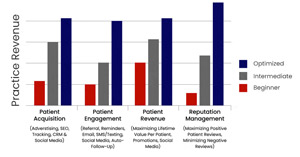
Case study: Impact of good content on your medical marketing
In the example below, we will walk you through a real example. In Nov 2019 customer signed for PatientGain Services. Example medical clinic has 3 locations, and is located on the east coast, starts using GOLD service from PatientGain. With specific focus on improving organic traffic from Google search engine. The medical clinic has been in business for 16 years. They have gone through 5 different online website services in the last 16 years. In the 3 locations, they have total of 13 providers, 28 exam rooms, and their services include 1) pain management 2) fibromyalgia treatment 3) complex regional pain syndrome 4) vertebral fracture 5) spinal cord stimulators 6) interventional pain medicine 7) kyphoplasty & sacroplasty 8) peripheral nerve stimulators 9) sacroiliac joint fusion and several more.
In the diagram below, at launch Nov-Dec data was as follows:
- The website had been in place for 16 years.
- Over 100 pages of content – majority of the content was plagiarized and copied from other sites
- Website was on a shared server, very cheap hosting, so pages will load but slowly
- Mobile friendly
- Technical structure of the website not well
- Average of 36 organic clicks per day
- Average of 8K organic impressions per day
So overall you would say, they are doing OK.
In the diagram below, data was as follows:
- The website was redone using WordPress and PatientGain‘s apps in December
- Over 100 pages of content – had been cleaned up. Resulting in 62 good pages of content, and addition of specific service based pages.
- Website was moved to Google Cloud Servers
- Mobile friendly and mobile optimized, A/B tested design.
- Technical structure of the website was totally redone – 20 apps and a Medical CRM was added
- Average of 132 organic clicks per day
- Average of 23K organic impressions per day
So overall 36 organic clicks to 132 organic clicks per day is a big improvement. Number of impressions per day increased to 23K per day.
Another important factor, not measured by this diagram is the actual patient count, which improved also, similarly.
So what was done? Content improvement was the major effort. Hence by adding high quality content, staying on-topic, and providing useful information on your medical website, not only you will serve your patients well, you will also increase SEO rankings and serve your wallet well.
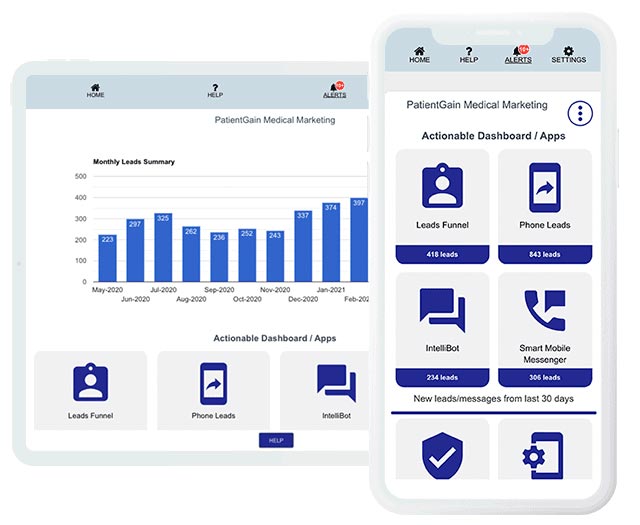
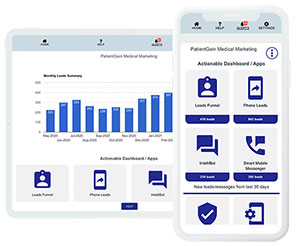
Medical Marketing Is Moving To Online Mediums
Best medical practices are now using Medical Marketing CRMs to gain competitive advantage. These marketing CRMs are connected and integrated with medical websites and intelligent patient engagement ChatBots.
What is a Medical Marketing CRM ?
As patients interact with your website, your email marketing, Texting/SMS, Facebook business page, you would want to store the information about each interaction in a database. This database is called a medical marketing CRM (HIPAA Compliant). It is an intelligent software that can also integrate with your EMR or EHR system securely, and leverage the hidden useful information in your EMR. So medical marketing CRM software is used to store prospect patient information and patient interactions, before a patient becomes a patient. Many times, after a prospect patient has been converted to a patient, you would still want to keep the patient information, in addition to your EMR. EMR and Practice Management or Patient Billing/Revenue systems are not designed to market to patients. Lead capture and follow up is becoming important as patients require multiple touch points.
In addition your medical marketing CRM should integrate with software based on intelligent Bots. The intelligent ChatBots are becoming increasingly an essential part of a medical marketing strategy for doctors in US and Canada. Our data shows that by using in integrated medical marketing CRM, your ROI will increase 4% to 11% from your online advertising dollars. Reason: A lead-capture CRM database connected to your website, Facebook allows you to automate patient acquisition.
Medical Advertisement is More Than Putting a Sign-out Front Saying, “Accepting New Patients”
As the owner of a medical practice, you need to advertise your business to maintain and build your patient count. Medical advertisement is more than putting a sign-out front saying, “The Doctor Is In.” While this may work in the movies, a bit more effort must be made by a business owner in the highly competitive world of healthcare to achieve the results they want. Read more about 8 Good Medical Advertisement Examples For Doctors.
What Are Three Basic Components of Successful Medical Marketing?
There are dozens of things you can do to improve your medical marketing. However as a physician or medical practice manager’s point of view it boils down to:
- Getting Found: Getting patients to get to your website
- Conversion: Once the patient is on your website, do they take an action?
- Follow Up: Once patient has given you the phone number, or Email address or texted you from the website, how do you efficiently answer questions and provide a reason for the patient to become your customer.
Once you have understood these basic 3 high level strategies, you now have the ability to look at applications, services for your medical marketing. You may decide to do following :
- Do it yourself – much harder and often you will not get desired results – there is a lot of trial and error in medical marketing, concepts and technology is changing too fast.
- Hire a medical marketing company to do it for you.
- Hybrid model. Where you can have pieces of technology from multiple companies and use your own website.
